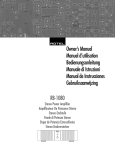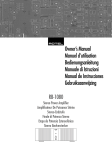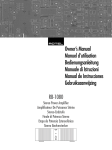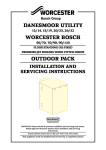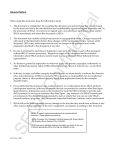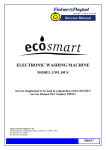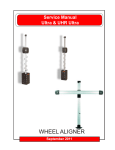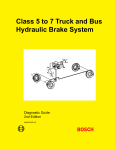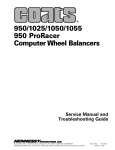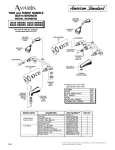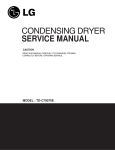Download Class 5 to 7 Truck and Bus Hydraulic Brake System
Transcript
Class 5 to 7 Truck and Bus Hydraulic Brake System Diagnostic Guide 1st Edition BOSCH Important Service Notes The information in this publication was current at the time of printing. The information presented in this publication is subject to change without notice or liability. The information contained in this publication is intended for use by properly trained and equipped professional technicians. It is NOT for the “Do It Yourselfer” Failure to follow safety and repair procedures can result in personal injury, or damage to vehicles, components and equipment. Failure to follow all the safety and vehicle repair procedures either contained in this manual, in the chassis and vehicle manufacturer's repair manuals or in accordance with other accepted methods can result in personal injury, death, or damage to components, vehicles, or personal property. Correspondence concerning this manual should be addressed to: Robert Bosch Corporation Attn: Hydraulic Actuation & Truck Brake Engineering 401 North Bendix Drive South Bend, Indiana 46628 FAX: 574-237-2210 August 2003 Contents Preface..................................................................................................................................... 3 Purpose of this diagnostic guide Using this diagnostic guide Exclusions Brake System Diagram............................................................................................................. 4 Schematic of Typical Electrical System.....................................................................................5 Brake Warning Light and Buzzer Do Not Shut off.....................................................................6 Booster Backup Pump Runs Continuously.................................................................................7 Booster Backup Pump Does Not Run........................................................................................8 Brake Pedal Continues to Fall With Steady Foot Force............................................................ 9 Brake Pedal Feels Spongy, Soft or Springy............................................................................... 9 Brake Pedal Feels Very Hard................................................................................................... 10 Potential Master Cylinder and Booster Leak Points................................................................. 11 Leakage....................................................................................................................................12 Brake Drag...............................................................................................................................15 Master Cylinder Cap Diaphragms............................................................................................19 Low Shoe Pad Life or Uneven Shoe Pad Wear.......................................................................... 20 Printed in the United States of America Copyright © 2003 Robert Bosch Corporation Class 5 to 7 Truck & Bus Hydraulic Brake System Diagnostic Guide 3 1 Class 5 to 7 Truck & Bus Hydraulic Brake System Diagnostic Guide 4 2 Preface Purpose Of This Diagnostic Guide The purpose of this diagnostic guide is to assist Class 5 to 7 hydraulic brake repair technicians to more accurately and quickly diagnose the most likely causes of a customer's brake related complaint. This diagostic guide is NOT a repair instruction, but only a guide. When the probable cause of a customer's complaint is established, the repair procedure must be done in accordance with the instructions in the vehicle manufacturer's service manual. Using This Diagnostic Guide The brake technician must be able to understand the customer's complaints and description of the symptoms well enough to match them to one (or more) of the categories listed in the Table of Contents. Most customer complaints and symptoms on the vehicle can be matched to these categories. Each category has a corresponding flow chart that will lead the brake technician to the most likely cause of the customer's complaints and vehicle symptoms. Several of the flow chart paths end with a comment box that also includes a number. Brake technicians can use this number to document why a Bosch manufactued part was replaced. IMPORTANT REMINDER: The first step in diagnosing any customer complaint is to confirm the customer's complaint and determine which category applies. The flow charts show which diagnostic steps need to be taken. The brake technician must have the necessary skills needed to perform each step. The flow charts are structured to guide the brake technician to take the quickest and easiest steps first. Often, these first, simple steps will be enough to determine what repair needs to be made. After completion of all diagnostic steps, the brake technician must remember to tighten any tube nuts, fittings, bolts, screws, bleeder screws, etc., that were loosened as part of the diagnostic procedure. In all cases, the vehicle manufacturer's service manual must be used for any repair instructions. Brake system warning lights and buzzers are unique to the vehicle manufacturer. The Brake Warning Light and Buzzer Do Not Shut Off flow chart offered in this guide is generic and may not apply to all vehicles. The vehicle manufacturer's service manual must be consulted in order to determine the proper function of these warning devices. Exclusions The ABS portion of the hydraulic brake system is not addressed in detail in this guide since the ABS hardware and software are unique to the specific vehicle manufacturer. Any diagnosis or repair needs to be done in accordance with the vehicle manufacturer's ABS service manual. Class 5 to 7 Truck & Bus Hydraulic Brake System Diagnostic Guide 35 Hydraulic Brake System Diagram Hydraulic Booster Monitoring Device That Controls Warning Light and Buzzer Brake Pedal and Linkage Master Cylinder Power Steering Reservoir Power Steering Pump Power Steering Gear Booster Backup Pump Brake Caliper ABS Hydraulic Control Unit Figure 1. Brake System Components ΝΟΤΕ: Use appropriate brake component or vehicle manufacturer's service manual for all repair work. Class 5 to 7 Truck & Bus Hydraulic Brake System Diagnostic Guide 6 4 Schematic of Typical Electrical System Flow switch harness ground (optional) Fluid level indicator switch Flow switch Differential pressure switch Backup pump Ignition switch Chassis ground Relay Figure 2. Schematic of Typical Electrical System ΝΟΤΕ: Use appropriate brake component or vehicle manufacturer's service manual for all repair work. Class 5 to 7 Truck & Bus Hydraulic Brake System Diagnostic Guide 7 5 Brake Warning Light and Buzzer Do Not Shut Off TIP The light and buzzer come on together, typically in response to signals from the parking brake switch, booster flow switch, master cylinder fluid level indicator switch, the master cylinder differential pressure switch or booster backup pump (See Figure 2). Is master cylinder reservoir more than 1/2 full? No Yes Fill master cylinder reservoir with appropriate type brake fluid. Is the master cylinder differential pressure switch closed to ground? No See Booster Backup Pump Runs Continuously section or Booster Backup Pump Does Not Run section, as appropriate. Are light and buzzer still ON? No - Check brake fluid system for leakage per Leakage section - Check shoe pads for wear Yes Yes Check master cylinder fluid level reed switch for continuity. No Continuity Continuity 1 The problem is probably with the master cylinder fluid level reed switch. Is there a leak in the brake fluid system? No 2 The problem is probably with the master cylinder differential pressure switch. Yes Diagnose per Leakage section. After repair completion, push very hard on the brake pedal to shut OFF differential pressure switch. ΝΟΤΕ: Use appropriate brake component or vehicle manufacturer's service manual for all repair work. Class 5 to 7 Truck & Bus Hydraulic Brake System Diagnostic Guide 8 6 Booster Backup Pump Runs Continuously TIP The booster backup pump can run only if the relay is closed. The relay will be closed only if: 1) the flow switch is closed and there is power to the coil, or 2) the relay is stuck closed. Is ignition key ON while condition exists? Yes No Is engine running? Are brake lights OFF? No No Yes The problem is probably with the brake light switch. Yes Normal condition Is there voltage to the relay coil? Unplug connector from flow switch Is booster backup pump still running? No 3 The problem is probably with the booster backup pump relay. Yes No The problem is probably with the ignition switch. Yes 4 Check for proper power steering pump flow by rapidly rotating the steering wheel. (The alternative is to measure the fluid flow.) The problem is probably with the booster backup pump relay. Does steering wheel rotate normally? Is flow OK? No The problem is probably with the power steering pump. Yes 5 The problem is probably with the booster flow switch. ΝΟΤΕ: Use appropriate brake component or vehicle manufacturer's service manual for all repair work. Class 5 to 7 Truck & Bus Hydraulic Brake System Diagnostic Guide 9 77 Booster Backup Pump Does Not Run TIP The booster backup pump will not run if there is no voltage to the motor or if the motor is damaged (e.g., burned out or jammed). A no-voltage condition can occur because: 1) Battery is dead 2) Relay is stuck 3) Wires are broken (battery to motor circuit or ignition switch / brake light switch to booster flow switch circuit) 4) Booster flow switch is not closed to ground Is there proper voltage to the booster backup pump? No Yes - Disconnect booster flow switch connector - Check continuity from relay to connector and - Check continuity through flow switch 6 The problem is probably with the booster backup pump. Is wire continuity OK? No Yes 7 The problem is probably with the wire. Is flow switch continuity OK? No Yes The problem is probably with the booster flow switch. Is there voltage to the relay coil? No Yes Check ignition relay circuit and brake light switch to relay circuit for continuity and properly functioning switches. Is there battery voltage to the relay? No The problem is probably with the battery to relay circuit. Check it for continuity. Yes 8 The problem is probably with the relay. ΝΟΤΕ: Use appropriate brake component or vehicle manufacturer's service manual for all repair work. Class 5 to 7 Truck & Bus Hydraulic Brake System Diagnostic Guide 10 7 8 Brake Pedal Continues to Fall With Steady Foot Force Is there visible brake fluid leakage from: - master cylinder? - ABS hydraulic unit? - disc brake calipers (watch for expanding piston boots)? - tubes, hoses, or connections? No Yes Is ABS light on? No 9 The problem is probably due to internal bypass of brake fluid inside master cylinder. See Leakage section. Yes The problem is probably with ABS hydraulic unit. Brake Pedal Feels Spongy, Soft or Springy TIP If the brake pedal does NOT fall with steady foot pressure but feels spongy, soft or springy, the problem is probably caused by air trapped in the brake fluid system. Start by bleeding the brake system at the caliper furthest from the master cylinder and work from the back to the front of the vehicle. ΝΟΤΕ: Use appropriate brake component or vehicle manufacturer's service manual for all repair work. Class 5 to 7 Truck & Bus Hydraulic Brake System Diagnostic Guide 11 99 Brake Pedal Feels Very Hard TIP The most common reasons for a very hard brake pedal are: 1) Insufficient flow or pressure from the power steering pump 2) The ABS hydraulic unit is blocking the flow of brake fluid to the calipers With engine OFF, does brake pedal feel very hard? No - Check for proper power steering pump flow and pressure - If the steering wheel cannot be rotated rapidly, or if flow is measured and found to be low, the problem is probably with the power steering pump Yes Does the booster backup pump run? No Yes See Booster Backup Pump Does Not Run section. Does the booster backup pump sound like it slows down when pushing harder on the pedal? No 10 The problem is probably with the booster backup pump. Yes The problem is probably with the ABS. ΝΟΤΕ: Use appropriate brake component or vehicle manufacturer's service manual for all repair work. Class 5 to 7 Truck & Bus Hydraulic Brake System Diagnostic Guide 12 10 Potential Master Cylinder and Booster Leak Points Flow switch seal Booster outlet port Inlet port seal Reservoir to body interface Master cylinder outlet ports Booster to master cylinder interface Booster housing to backup pump interface Figure 3. Potential Master Cylinder and Booster Leak Points ΝΟΤΕ: Use appropriate brake component or vehicle manufacturer's service manual for all repair work. Class 5 to 7 Truck & Bus Hydraulic Brake System Diagnostic Guide 13 10 11 11 Leakage TIP Most external leakage is easy to detect by wetness and/or appearance of fluid drops. However, slight dampness (no drops or wetness) may not indicate a leak. Is the leak at the booster, master cylinder, ABS hydraulic unit, brake caliper, or tubes and hoses? Booster or Master Cylinder ABS Caliper Continued Continued on on Next Page next page See ABS or vehicle manufacturer’s service manual. Is leak at the bleed screw? Yes No Tighten bleed screw to manufacturer’s recommended torque. Is leak at the brake hose tube fitting? Yes No Tighten tube fitting to manufacturer’s recommended torque. Does it still leak? No Replace tube seat or bleed screw. Tighten to manufacturer’s recommended torque. Complete Does it still leak? Yes No Complete Yes Replace tube seat or fitting. Tighten to manufacturer’s recommended torque. Does it still leak? No Complete Does it still leak? No Complete Yes 12 The problem is probably with the caliper. Yes 11 The problem is probably with the caliper. ΝΟΤΕ: Use appropriate brake component or vehicle manufacturer's service manual for all repair work. Class 5 to 7 Truck & Bus Hydraulic Brake System Diagnostic Guide 14 12 Leakage (continued) TIP Brake fluid mixes with water. Power steering fluid floats on water. From previous page Examine booster & master cylinder assembly. Is leak at booster to master cylinder interface? (See Figure 3) Yes No Determine if the leak is brake fluid or power steering fluid. See TIP. Is leakage at booster or master cylinder? Booster - Thoroughly clean the entire booster with soap & water, then dry it - Start engine, apply brakes with normal foot pedal force several times and look for a point of leakage. Continue as necessary until leak is found Continued on next page Power Steering Fluid Brake Fluid Master Cylinder Can the leakage be fixed by tightening the tube nuts or replacing the tube seats? - Thoroughly clean the entire booster with soap & water, then dry it - Start engine, apply brakes with normal foot pedal force several times and look for a point of leakage. Continue as necessary until leak is found No Yes Tighten tube nuts to manufacturer’s recommended torque or replace tube seats as needed. 13 Replace master cylinder. Continued on next page ΝΟΤΕ: Use appropriate brake component or vehicle manufacturer's service manual for all repair work. Class 5 to 7 Truck & Bus Hydraulic Brake System Diagnostic Guide 15 13 13 Leakage (continued) From previous page Is booster flow switch leaking? Yes No Is leak at booster inlet port? No Yes Is leak at booster backup pump? No Is leak at the interface between the booster housing and the backup pump? Or, if an adapter is present, between the adapter and the housing or the adapter and the pump? No 16 The problem is probably with the booster. 14 The problem is probably with the flow switch O-ring seal. The problem is probably with the booster inlet fitting O-ring seal. Yes 15 The problem is probably with the backup pump. Yes Clean and examine all sealing surfaces and seal grooves at backup pump, booster housing, and adapter. Are surfaces and grooves flat and free of damage? No 17 The problem is probably with the damaged component. Yes 18 The problem is probably with the seals. ΝΟΤΕ: Use appropriate brake component or vehicle manufacturer's service manual for all repair work. Class 5 to 7 Truck & Bus Hydraulic Brake System Diagnostic Guide 16 14 Brake Drag TIP Possible Causes of Brake Drag: 1) Booster does not return 2) Brake pedal does not return 3) Brake hoses and tubes collapsed or kinked 4) Master cylinder does not return 5) ABS traps pressure 6) Brake caliper does not release - Remove filler cap from the master cylinder - Look at the diaphragm, inside the cap - Is the diaphragm swollen (See Figure 4) No Yes - With engine OFF, measure location of the pedal from the floor - Start engine and measure if pedal dropped to a new position - Shut OFF engine and measure if pedal returned to original position Did pedal drop about 1/2" when engine started? No Yes Two people will be needed for this step. - Apply and release brakes, then quickly loosen bleed screw at the suspected caliper(s). - The bleed screw must be loosened quickly, in case trapped pressure at the caliper bleeds down before the bleeder screw is loosened. - Does fluid spurt out under pressure? - Tighten bleed screw to manufacturer’s recommended torque. No - Remove caliper and shoe pads - For rear axle, disconnect axle from hub - Does rotor spin freely No Master cylinder has been contaminated with the wrong fluid. - Replace all of the following: master cylinder, all calipers, ABS hydraulic unit, and all rubber hoses. - Flush the steel brake tubes with clean brake fluid prior to installing new brake components. The problem is probably with the power steering pump. Yes The problem is probably with the booster, master cylinder or ABS. Continued on page 17 Yes The problem is probably with bearing pre-load. Caliper assembly is probably dragging. Continued on next page ΝΟΤΕ: Use appropriate brake component or vehicle manufacturer's service manual for all repair work. Class 5 to 7 Truck & Bus Hydraulic Brake System Diagnostic Guide 17 15 15 Brake Drag (continued) From previous page - Replace caliper without shoe pads, and tighten slide pin bolts in proper sequence and to correct torque - Slide caliper in and out by hand - Does caliper move freely No 19 The problem is probably with the pins, if pin slide, or rails, if rail slide type brake. Yes - Remove caliper and replace shoe pads - Slide shoe pads side to side - Do shoe pads move freely No 20 The problem is probably with the shoe pads. Yes 21 The problem is probably with the pistons in the caliper. ΝΟΤΕ: Use appropriate brake component or vehicle manufacturer's service manual for all repair work. Class 5 to 7 Truck & Bus Hydraulic Brake System Diagnostic Guide 18 16 Brake Drag (continued) TIP Prior to moving master cylinder 1/8 inch away from booster, loosen two diagonally opposed nuts that hold the master cylinder to the booster, by 1/8 inch. Have a power tool ready to loosen the remaining two nuts after the brakes have been applied and released. From page 15 Two people will be needed to do this step. - Apply and release brakes, then quickly loosen primary brake line tube nut at the master cylinder. - The tube nut must be loosened quickly in case trapped pressure at the master cylinder bleeds down before the tube nut is loosened. Does fluid spurt out under pressure at the brake line tube nut? Yes No - - Tighten brake line tube nut to manufacturer’s recommended torque - Apply and release brakes, then quickly loosen secondary brake line tube nut - Retighten tube nut The problem is probably with the ABS. No Does fluid spurt out under pressure at the brake line tube nut? Yes Two people will be needed for this step. - Tighten tube nuts to manufacturer’s recommended torque. - Apply and release brakes. - Shut-off engine. - After releasing brakes, quickly loosen the four nuts (see TIP) holding the master cylinder to booster, by 1/8 inch. - Quickly pull master cylinder away from booster, and quickly loosen primary brake line tube nut. - All of these steps must be done quickly in case trapped pressure at the master cylinder bleeds down before the tube nut is loosened. Continued on next page ΝΟΤΕ: Use appropriate brake component or vehicle manufacturer's service manual for all repair work. Class 5 to 7 Truck & Bus Hydraulic Brake System Diagnostic Guide 19 17 Brake Drag (continued) From previous page Does fluid spurt out under pressure at the tube nut? No Yes - The problem is probably with the booster or pedal linkage - Retighten tube nut - Retighten 4 nuts to 34 to 41 Nm 22 The problem is probably with the master cylinder. Apply and release brakes, then quickly do the following: - Remove pin that holds the pedal rod to the pedal arm. - Open primary tube nut at master cylinder. - These steps must be done quickly in case trapped pressure in the master cylinder bleeds down before the tube nut is loosened. Does fluid spurt out under pressure at the tube nut? No Yes - Retighten the tube nut -The problem is probably with the pedal linkage 23 - Retighten the tube nut - The problem is probably with the booster ΝΟΤΕ: Use appropriate brake component or vehicle manufacturer's service manual for all repair work. Class 5 to 7 Truck & Bus Hydraulic Brake System Diagnostic Guide 20 1817 Master Cylinder Cap Diaphragms Diaphragm swollen due to exposure to mineral oil (power steering fluid, automatic transmission fluid, motor oil, etc.) Normal diaphragm Figure 4. Comparison: Swollen vs. Normal Diaphragm ΝΟΤΕ: Use appropriate brake component or vehicle manufacturer's service manual for all repair work. Class 5 to 7 Truck & Bus Hydraulic Brake System Diagnostic Guide 21 19 19 19 Low Shoe Pad Life or Uneven Shoe Pad Wear TIP Shoe pad life can vary greatly due to many factors including vehicle type, vocation (e.g., rollback tow truck, box truck, bus, etc.), terrain, urban vs. rural use, and driver style. Therefore, no guidelines can be provided for the mileage that should be obtained. Verify condition that shoe pads are wearing abnormally (excessive inner vs. outer shoe pad wear). Are brakes dragging? No Yes Do brakes show signs of heat exposure? No For low brake operating temperature conditions, see service manual for appropriate alternate replacement shoe pads. See Brake Drag section. Yes Condition is probably related to the duty cycle (usage) or the driver’s braking habits. ΝΟΤΕ: Use appropriate brake component or vehicle manufacturer's service manual for all repair work. Class 5 to 7 Truck & Bus Hydraulic Brake System Diagnostic Guide 22 20 Correspondence concerning this manual should be addressed to: Robert Bosch Corporation Attn: Hydraulic Actuation & Truck Brake Engineering 401 North Bendix Drive South Bend, Indiana 46628 Fax: 574-237-2210 Printed in the United States of America Copyright © 2003 Robert Bosch Corporation























